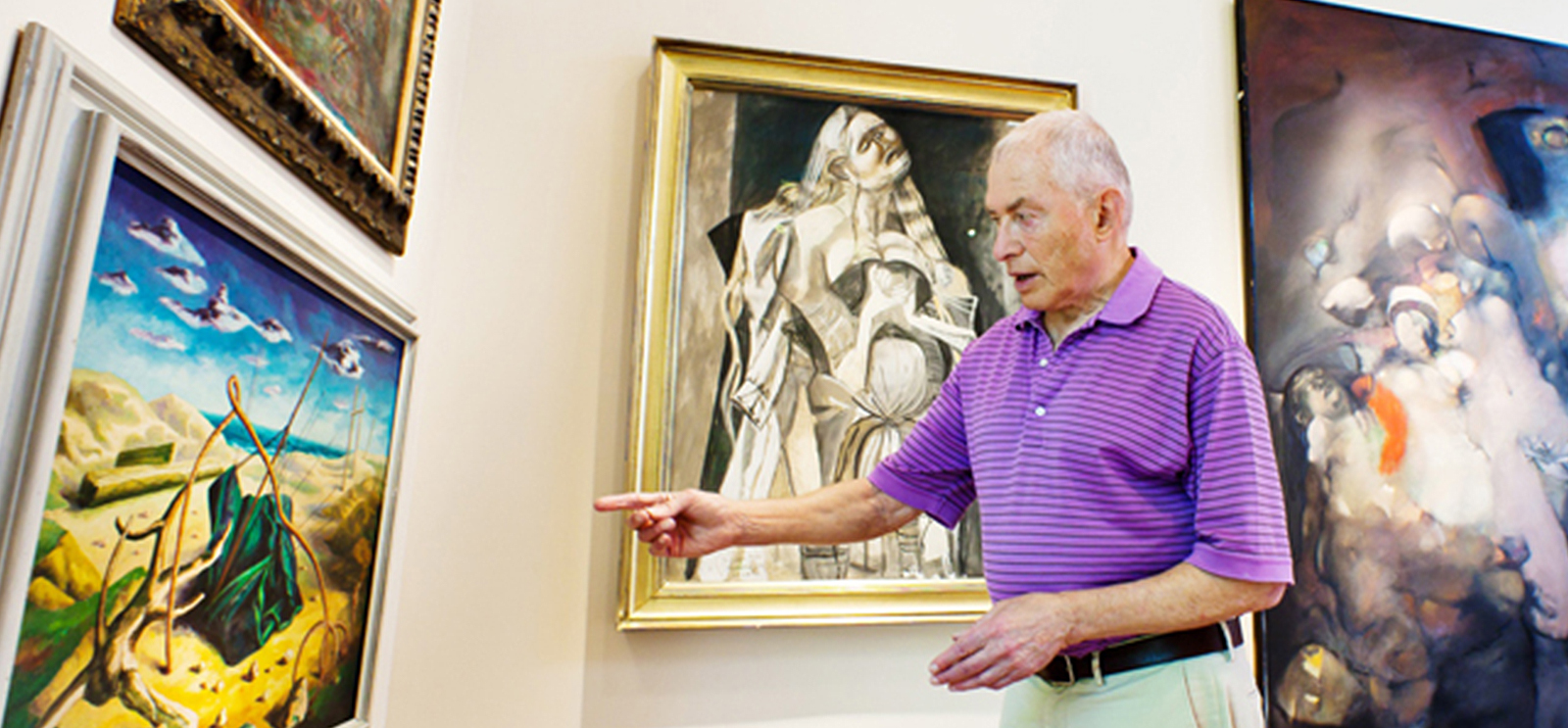
Schiller's current collection at his Highland Park, Illinois, home includes about 250 American surrealist works. (Photo by Jason Smith)
Philip Schiller, AB'55, built one of the country's most comprehensive collections.
"There's no reason in my background for me to be interested in art," says Philip Schiller, U-High'52, AB'55. "No one in my family collected." He had enough curiosity to take art-appreciation courses in the College, and later his wife, Suzanne, "would grab me to go to the Art Institute," but that was it.
Yet at 75, Schiller, a real-estate attorney and investor, has sold a major collection to a museum, and he's now amassing a second collection at his home in Highland Park, Illinois, near Lake Michigan. In the house, designed by architect Howard Van Doren Shaw, framed art covers every wall: colorful and sometimes foreboding paintings in the kitchen and up the staircase, black-and-white prints in the den, and large canvasses in the open gallery space he and Suzanne added in back as their collection grew.
The Schillers cultivated their first collection for 35 years, focusing it in both style, which he calls American social commentary, and period, between 1930 and 1970. It captured the century's social upheaval, including the Great Depression, World War II, McCarthyism, the civil-rights movement, and the Vietnam War. From 1995 to 1998, five dozen of their works toured the country in an American Federation of Arts exhibition, In the Eye of the Storm: An Art of Conscience, 1930–1970.
In 2005 the Schillers sold around 400 pieces, valued at an estimated $7 million, to the Columbus Museum of Art. The works included Ben Shahn's 1956 painting Study for Goyescas, in which a man who is part military and part religous leader simultaneously clasps his hands and plays cat's cradle over a pile of corpses; Jacob Lawrence's 1937 Interior Scene, depicting a Harlem brothel with white johns; and a companion piece, Street Scene—Restaurant, which shows black prostitutes and a nervous-looking white man approaching. After the collection's sale was announced, Virginia Mecklenburg, senior curator of the Smithsonian American Art Museum, told the Columbus Dispatch that the Schillers' was "one of the most focused and comprehensive private collections in the country."
At first he bought by instinct. For Schiller's 40th birthday in 1976, he and Suzanne went to New York to survey the art scene. He had already purchased one major piece, a Reginald Marsh ink drawing of a young woman walking down a street, which tipped his interest in art about urban life. Schiller's friend Dino D'Angelo, AB'42, JD'44, a collector himself, had introduced Schiller to Marsh's work.
On D'Angelo's advice, he and Suzanne visited a handful of dealers and galleries. They fell in love with Robert Gwathmey's 1963 oil painting Custodian. In it a man and a woman sit in the foreground beside a rusted-out car and a scarecrow holding a watermelon. The rest of the painting is a deep yellow, suggesting the brutal heat of a Southern summer. The Schillers paid $15,000 for it, in installments.
"I now know the market much better than I did then," Schiller writes in his 1999 book Buy What You Love: Confessions of an Art Addict, "and there is no question that we overpaid for Custodian." Still, he's glad they did. "Even today when I look at it and am hit by the heat of that punishing sun," he writes, "I know that buying it was exactly the right thing to do." Schiller's aesthetic instincts eventually proved financially sound. Since Gwathmey's 1988 death, his paintings' values have risen; Custodian was included in the Columbus museum sale.
Soon Schiller became a regular at New York galleries and eventually at auctions. He hung the works he bought, either in Highland Park or at his Florida winter home. "I knew I was onto something," he says, when art historians or curators would come for a short visit and stay for hours.
Although many of his purchases became good investments, he advises collectors to buy art they love, pieces they will want to look at every day. If you're in it for the money, he writes, "Give it up. Your chances are so small it's not worth trying." In fact, "the rule of thumb, at least with contemporary art, is that 99 percent of what you buy will be worth less than what you paid."
As his own collection narrowed in style and period, he began to feel it "could be of importance," Schiller says. He wanted to keep the works together so they "could be understood as a whole." The Columbus Museum of Art bought the collection, adding to its contemporary holdings. Now the Schillers visit their former paintings a few times a year. More often they look at them in their art books.
Today their home is filled with art again, this time 20th-century American surrealism. They have around 250 pieces, Schiller says, "the makings of a very interesting collection" and one "not as restricted" in period or subject matter. Although he doesn't yet know what will happen to these works, he enjoys looking at them every day.
